In many laboratory projects, it is necessary to provide the right conditions and environment for the experiment in order to obtain the correct test results with less error. One of these conditions that has an inescapable effect on the final results of the test is the washing of laboratory containers. There are various methods for washing laboratory utensils in different laboratories due to the dif
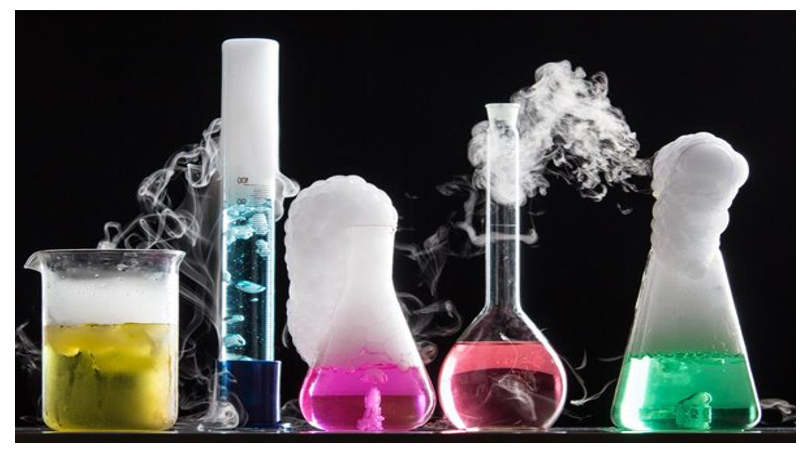
In many laboratory projects, it is necessary to provide the right conditions and environment for the experiment in order to obtain the correct test results with less error. One of these conditions that has an inescapable effect on the final results of the test is the washing of laboratory containers. There are various methods for washing laboratory utensils in different laboratories due to the different types of contamination, one of these methods is manual washing, which requires washing with acid or base, disinfectants, pouring water or immersion in water. It can be done in plastic pans. This method requires that after the washing process is completed with disinfectant solutions, which are selected according to the type of contamination of the dishes, they are taken under distilled water, which usually completes the washing process. It should be noted that hot soapy water can also effectively clean contaminated glass containers.
During the cleaning of laboratory glassware , acidic and alkaline substances and strong detergents may be used, some of which are flammable and corrosive and can cause serious harm to the user if they come into contact with the skin. In addition, the vapor from these materials may also irritate the user's respiratory tract. In addition to these issues, working with the glass of laboratory instruments itself also brings risks. Broken or cracked glass can cause injury to the user. For this reason, it is necessary to observe safety precautions when cleaning laboratory glassware. In the following, we have mentioned some of the most important points for you.
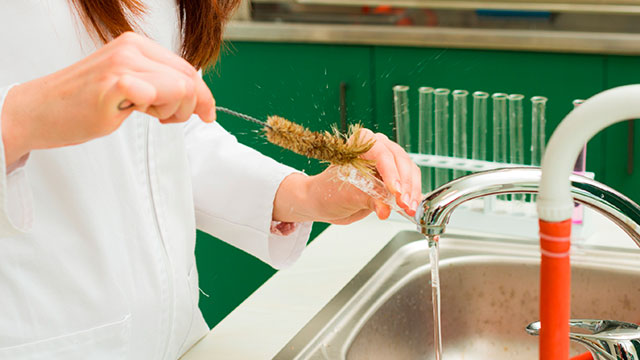
1- To avoid breaking containers and harming the user, be careful in their storage and transportation.
2- Inspect glass containers before each use and do not use them if there are scratches or cracks on the container.
3- Use soft brushes and sponges to clean laboratory glassware.
4- When cleaning the inside of the glass containers, be careful that there may be cracks or breaks inside them and lead to injuries and cuts.
5- Use plastic mats on the sink to reduce the possibility of breaking laboratory glassware.
6- Do not overfill the sink.
7- Avoid placing metal and hard objects such as laboratory stirrer rods, etc. inside glass containers. Because this may cause the glass to be scratched and broken.
8- Never use strong alkaline products and hydrofluoric acid as cleaning agents. These substances dissolve the glass and can injure the user.
9- Never use heat to remove carbon residue on dishes. Heating glass containers above 800°F (about 400°C) can cause the glass to break.
10- To dry the dishes, be sure to put them on the drying rack.
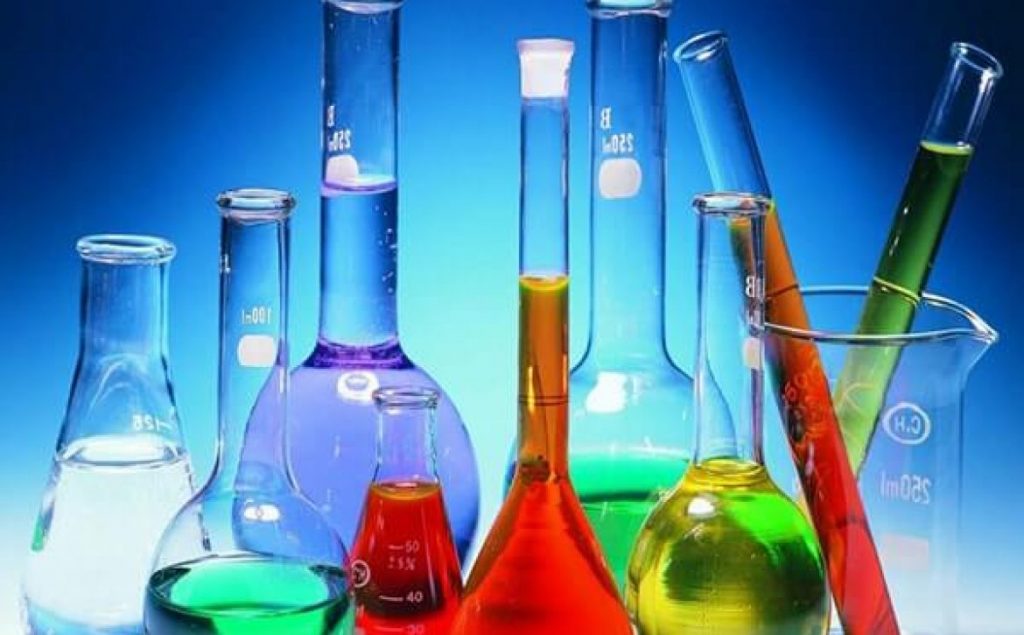
11- In case of broken containers, be sure to use appropriate equipment to collect the broken pieces and never collect the pieces by hand. Broken glass should be collected in appropriate labeled sharps waste containers.
12- Play baths, which are used to clean laboratory glassware, are very dangerous for the skin and eyes. For this reason, it is recommended to use personal protective equipment (PPE) such as laboratory coat, safety glasses and eye protection, gloves, face protection, etc. while cleaning laboratory glassware.
13- Do not store alkaline liquids in jujube balloons or burettes. This may cause the balloon cap or burette valve to stick to it.
14- The materials used to clean laboratory glassware are only suitable for glass containers. For this reason, avoid placing ceramic dishes etc. in these materials.
15- Note that placing glass containers in play bathrooms for a long time can damage these containers. For this reason, do not put too many containers in these materials.
16- Before putting the glass containers in the detergent, be sure to remove the plastic connections. Because detergents can cause corrosion of plastic materials.
17- Dispose of solvents and detergents safely after use.
1. The usual and traditional method of washing laboratory dishes 2. Using laboratory dishwashers 3. Autoclave for sterilizing laboratory containers 4. Using an ultrasonic device to wash laboratory dishes
1-Hydrochloric acid
2- Acetone
3-Ethanol
4- Distilled water
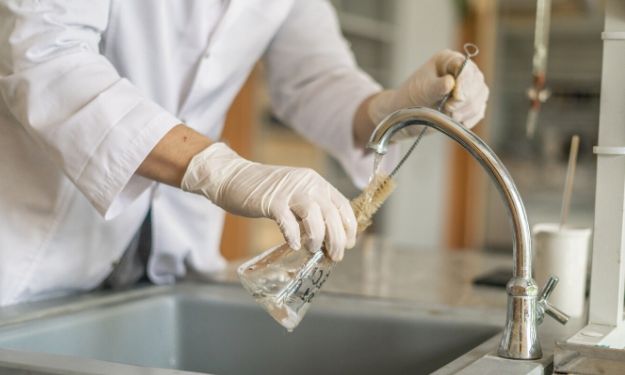
Obviously, you should always disinfect contaminated items before washing them. Alkaline compounds present on the surface of glassware impregnated with soda should be neutralized by placing them in a 5% hydrochloric acid solution and then rinsed several times with tap water and finally with distilled water. Hydrochloric acid is a clear, colorless and very pungent-smelling solution of hydrogen chloride (HCl) in water. A highly edible and strong mineral acid with many applications that is used for washing laboratory dishes, acid washing and metal washing, household and industrial cleaners and cleaners, PH control and neutralization. Hydrochloric acid is prepared in solutions of up to 38% concentrated HCl, and higher concentrations can only be produced chemically up to 40%. The major global producers of this substance include Dow Chemical Company, Axiall Corporation, Detrex Corporation and AGC Chemicals.
Acetone is the simplest and most important ketone with the molecular formula C3H6O, a colorless, toxic, volatile and flammable liquid. Due to its high polarity, it is considered a good solvent for most organic compounds and dissolves well in water, ethanol and ether. Acetone is a common solvent for washing laboratory glassware; Because it is a volatile material with reasonable cost. Sales of acetone (cleaning solvent) in many fields including: plastic industries, synthetic fiber manufacturing, pharmaceutical industries, wax, resin, fats, greases and oils manufacturing industries, poisons and some herbicides manufacturing industries are done and used. Placed. The largest acetone producer in the world is INEOS Phenol, which has the largest acetone production department (420,000 tons per year) in Bourne, Belgium, which has a capacity equal to 17% of the world's acetone production.
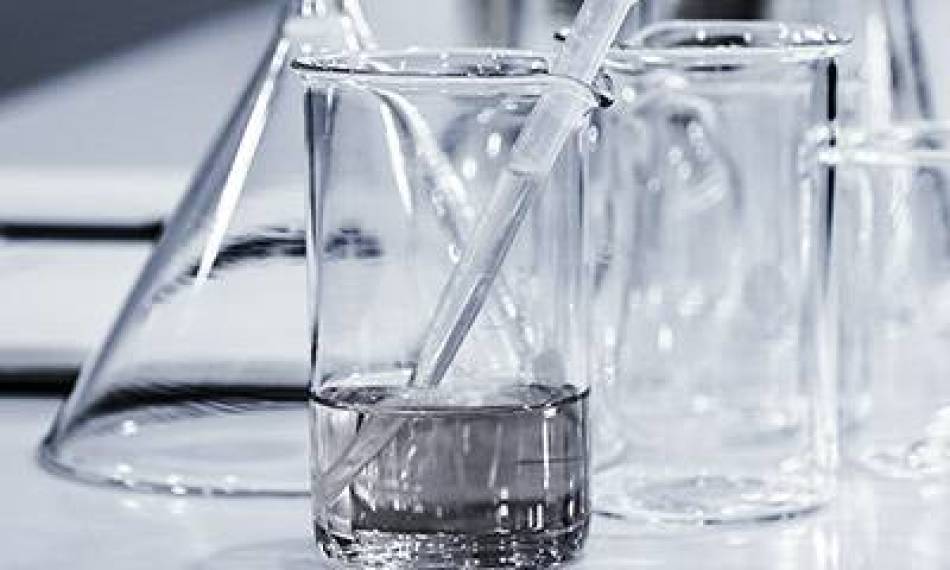
Laboratory ethanol, commonly called ethyl alcohol, ethyl alcohol, fruit alcohol, edible alcohol or simply alcohol, is produced by fermentation of sugars by yeasts. Ethanol is a very good solvent and therefore it is used in laboratories, pharmaceutical industries, perfume and cologne industries, paint and various other industries, and because of its very low melting point, it is widely used in the antifreeze industry. Sales of 70-85% ethanol is used as a disinfectant solution in many cases, including disinfection of laboratory equipment and medical instruments. Brazil is one of the main producers of ethanol in the world, and the global ethanol market is characterized by the prominent presence of companies such as Green Plains Inc., Flint Hill Resources, Solvay Group, and The Andersons. will be
This type of water is purified through the distillation process, and many of its impurities such as carbonates and compounds such as silica have been removed. The primary medium used in the distillation process can be tap water, but in most cases, natural water (spring, river, etc.) is used. Usually, this water is boiled and the resulting vapors are collected and condensed to form distilled water. While most minerals, salts, fine particles and some other impurities are separated, the primary water barrier is very important; Because many impurities (such as volatile organic substances and mercury) evaporate along with water. The most important use of distilled water is in industrial and pharmaceutical cases due to the absence of impurities and harmful salts. Of course, this type of water has many other uses, among which the most important uses include sterilizing equipment, cleaning laboratory glassware, making high-purity water, and as a solvent in the production of solutions. Due to the wide use of this product, distilled water is widely sold.
Ultrasonic cleaning is a powerful and optimal way to remove hard pollutants. Ultrasonic cleaner is a device that quickly and completely removes dirt, germs and any type of pollution from the desired surface. By placing the item we want to wash in the ultrasonic bath, its surfaces are cleaned due to the rapid movement of water and washing solution produced by the ultrasonic. Various pollutants such as oil and grease, chemicals, soil and any other type of pollution are easily removed in this method without the slightest damage. The ultrasonic cleaner not only makes cleaning easier, but also saves time and energy. Laboratory tubes, Erlenmeyer flasks, pipettes, balloons and any other laboratory equipment can be cleaned easily and quickly by ultrasonic, and more importantly, ultrasonic is completely safe.
Usually, ultrasonic cleaning of dishes and laboratory equipment is done using water and a mild detergent that does not harm the dishes. Various studies have shown that the ultrasonic cleaner can make your cleaning process up to 60 times faster.
To clean with an ultrasonic washing machine, it is necessary to place the items inside the tank basket so that the laboratory containers are not damaged. It is better to place these devices inside the solution and at least at a depth of more than 2.5 cm. It is better to use distilled water or deionized water in the ultrasonic washing machine. There are different chemicals for cleaning. Be sure to have the necessary information about these detergents before using them. You should never use alcohol or flammable solutions in the ultrasonic washing machine because it will cause a fire and the adapters used must have a water base, not alcohol. Acidic substances also damage the tank of the device. Turn on the device and set the temperature to 60°C for 10 minutes. Of course, this temperature and time can be different based on the nature of the device to be washed. After washing, remove the dishes from the machine. Then put them by hand or in the dryer to dry completely. Make sure that the cleaning solution of the ultrasonic device should not be used more than once. You must drain it and fill it with fresh water to wash it again. Ultrasonication alone will not kill bacteria. It is necessary to use a suitable disinfectant solution for disinfection. Of course, the autoclave can be used for sterilization after ultrasonic cleaning for laboratory equipment contaminated with biochemical substances.
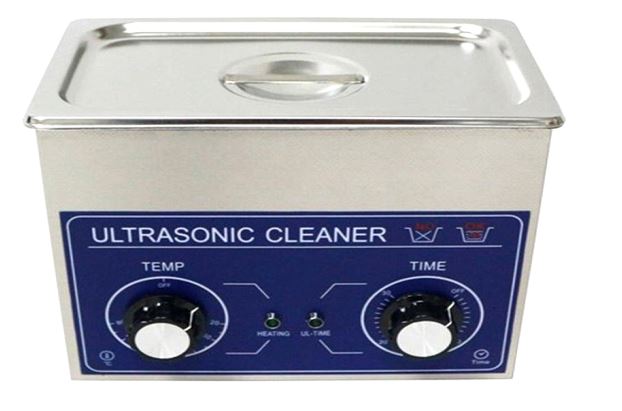
The special features of the ultrasonic washing machine have made this machine highly efficient in various industries, medical and laboratory uses. Among the advantages of the ultrasonic washing machine, the following can be mentioned.
There are various methods for washing laboratory utensils in different laboratories due to the different types of contamination, one of these methods is manual washing, which requires washing with acid or base, disinfectants, pouring water or immersion in water. It can be done in plastic pans. But ultrasonic washing is a powerful and optimal way to remove hard pollutants. Ultrasonic cleaner is a device that quickly and completely removes dirt, germs, and any type of pollution from the desired surface. It is used because of its good features, such as faster speed, the ability to wash delicate and sensitive items with details, etc. Placed.
